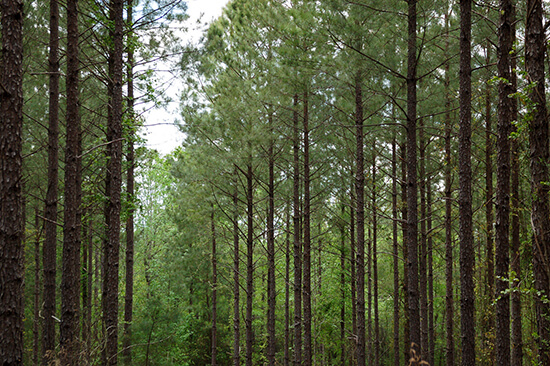FIA offers an integrated approach to climate solutions in forestry, built on three pillars that we believe contribute to sound investment and management of forests in a carbon-constrained world. These pillars enable us to meet our clients’ varying needs in climate-related management, from essential risk mitigation to climate disclosure to portfolio decarbonization. We appreciate that investors today face a range of options in their own climate targets, disclosure, and strategies; we aspire to be a trusted advisor to our clients in understanding the climate risks and potential climate opportunities of their forestry portfolios. Download our overview of Climate Solutions in Forestry Investment to learn more.

Forestry investments are exposed to chronic and acute impacts from changing climate conditions. Such impacts can be on the physical forest resource as well as affect forest operations, the labor force, markets, and supply chain logistics that influence the value of forests and the supply and demand for forest products. Examples of physical threats to forests include pests and disease, invasive species, wildfire, flooding, wind, and changes to ice stores and sea level rise. In addition, changing temperature and precipitation patterns can affect growth, productivity, health, and resilience of forests, which can compound the risks of the threats above.
Understanding both the physical risks and the potential financial impacts of those risks is a core component of forestry risk management. That is why we developed the Physical Climate Risk Assessment[1] guidelines to consistently identify and evaluate key physical risk factors that may affect the biological productivity, quality, and value of forestry assets. The approach leverages tools and analysis developed by third parties and scenario analysis for forestry assets under a range of future climate scenarios. It also aligns with FIA’s forest management programs, including our United States regional programs for certification under the Sustainable Forestry Initiative and its criteria related to climate-smart forestry, which include vulnerability assessments for forest resilience.
The steps outlined in the graphic below show how FIA approaches identification and evaluation of physical risks, utilizes scenario analysis tools and other regionally appropriate data, and then prioritizes mitigation activities and adaptation, where relevant. Each step is described further below.

[1] Guidelines currently apply for timberland investments in the United States only. FIA seeks to apply risk identification practices and asset protection strategies as relevant across all investments.
FIA identified a set of physical risks that are potentially material to risk management and valuation of forestry investments. These are a general set of hazards that can be applied to any asset. The risks are split between acute and chronic factors, noting whether the risks tend to relate to a significant discrete event (even if such events may be recurrent) or whether the risks relate to changing conditions that may have a more gradual or cumulative effect.
FIA uses several third-party tools and systems that can provide scenario analysis and/or that summarize the historical or forecast risk data relevant to some physical risks. FIA uses tools that generate fire and wind risk analysis based on historical data. While historical data does not predict future outcomes, understanding past impacts is instructive as FIA considers forward-looking risk profiles and how they may change under climate scenarios. FIA also uses the Climate Projection and Analysis Tool (CPAT), which was developed for US forests and considers productivity and planting data across a range of climate scenarios, allowing a tailored approach to climate scenario analysis focusing on environmental conditions and productivity.
Once these analyses are completed, FIA undertakes a risk assessment using a matrix informed by the steps of risk identification, evaluation, and data review. The matrix lists each of the physical risks and rates the potential risk to the asset using categories of Minor, Moderate, or Major, considering the scenario analysis and risk data to consider the severity of the likely impact. Each risk is assessed on this scale across three-time horizons: short (e.g., within 1-5 years), medium (5 years to rotation age), and long (beyond one rotation age).
Lastly, FIA seeks to identify and implement effective risk mitigation for material risk factors, including physical climate-related risks. FIA groups potential response measures under three types:
- R&D and Collaboration – Through R&D activities and collaborative memberships, FIA participates in regionally relevant research that has a range of aims that may support climate-related risk mitigation, adaptation, and resilience. In addition, through collaborative forums, such as research cooperatives, the SFI State Implementation Committees (SICs), and industry associations, including NCASI and NAFO, FIA strives to maintain visibility of changing threats and solutions related to environmental change as well as factors that may relate to climate transition risk, such as policy and markets.
- Tactical Activities – Through operational mitigation and adaptation measures, typically on-site, FIA seeks to implement tactical risk management to address risks and threats. Examples include: fuel breaks and fire lines to mitigate risk of fire spreading, participation in co-ops that provide fire response and suppression capability, pesticides to treat invasive species, and timing of planting and establishment to enhance likelihood of survival amidst shifting weather patterns.
- Strategic Activities – Through higher-level mitigation and adaptation measure, typically at the portfolio level, FIA seeks to diversify away from strategic risks and where severity levels for potential impacts would result in catastrophic losses or significant damage to asset value. Examples include geographic exclusions or diversification requirements, maintenance of standing timber insurance, and shifts in target species composition over time.
FIA believes that our physical climate risk assessment approach supports strong risk management practices tailored to forestry investments and the potential impacts they face from climate change. The approach can support investors who seek to align with the recommendations of the Task-force for Climate-related Financial Disclosure (TCFD) and those who have regulatory obligations or voluntary commitments to assess and disclose the threats and vulnerabilities of their investments from climate change. FIA’s approach seeks to align with the TCFD recommendations and its guidance for layered approaches through Governance, Strategy, Risk Management, and Metrics and Targets. We look forward to ongoing collaboration in the forest industry and real assets investment to develop climate-risk and resilience best practices that support long-term value for our clients from sustainable forestry investments.

Learn more by reaching out to FIA on the Contact Us page and download the resources below:


















